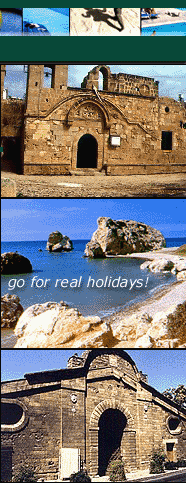|
Limassol
Successor
to two city-kingdoms and host to a Royal Wedding in the Middle Ages,
contemporary Lemesos stretches along the south coast. Proud of
the spontaneous hospitality of its people, its archaeological
sites, its mediaeval castles and its merry Carnival and Wine
festivals, Lemesos is the island's most important wine industry
centre. Hotels, restaurants and night spots abound along the beach
whilst close by lie the pine-clad southern slopes of Troodos with the
picturesque wine producing villages, the idyllic mountain resorts and
the picturesque Pitsylia area.
LIMASSOL
CASTLE - CYPRUS MEDIAEVAL, MUSEUM
Near the
Old Port. Tel: (05)330419 Built
in the 14th century on the site of an earlier Byzantine castle.
According to tradition Richard the Lionheart married Berengaria of
Navarre and crowned her Queen of England, here in 1191. The castle
houses the Cyprus Medieval Museum.
LIMASSOL
DISTRICT ARCHAEOLOGICAL MUSEUM
Kaningos-Vyronos Corner, near
the Public Gardens Tel: (05)330132 Interesting collection of
antiquities found in the Limassol area from the Neolithic Age to the
Roman Period.
FOLK
ART MUSEUM
253, Agiou Andreou - Tel:
(05)362303 This very beautiful collection of Cypriot Folk Art of the
19th and early 20th century is housed in a restored old house. The
collection includes national costumes, tapestry, embroidery e.t.c.,
displayed in a very interesting way,
LEMESOS
MUNICIPAL ART GALLERY
28 Oktovriou 103, Tel:
(05) 343212, 343383
The art gallery houses a representative collection of paintings of
well known contemporary Cypriot artists.
KOLOSSI
CASTLE
14 km west of Lemesos on
the road to Pafos. A fine example of military architecture,
originally constructed in the 13th century and subsequently rebuilt in
its present form in the middle of the 15th century. After the fall of
Acre in 1291, it served as the Grand Commandery of the Knights of the
Order of St. John of Jerusalem. In the 14th century it came for a few
years under the domain of the Knights Templar.
Nearby
are the ruins of a sugar mill dating to the 14th century.
KOURION
MUSEUM
14
km west of Lemesos, 4 km before Kourion site, at Episkopi village.
Collection of finds from nearby archaeological sites, exhibited in a
beautiful old house.
KOURION
19 km west of Lemesos on
the road to Pafos.
An important ancient city-kingdom, and one of the most spectacular
archaeological sites on the island where excavations still bring new
treasures to light.
The magnificent Graeco- Roman Theatre was originally built in the 2nd
century BC and is now fully restored and used for musical and theatrical
performances.
The House of Eustolios, originally a private Roman villa, became a
public recreation centre during the Early Christian period. It consists
of a complex of baths and a number of rooms with beautiful 5th century
AD mosaic floors. The Early Christian basilica dated to the 5th century,
was probably the Cathedral of Kourion with a baptistery attached to the
north face.
The House of Achilles and the House of the Gladiators have beautiful
mosaic floors. The Nymphaeum, dedicated to water nymphs. is an elegant
Roman structure.
The Stadium lies 1 km to the west on the right side of the road to Pafos
and is dated to the 2nd century AD.
SANCTUARY
OF APOLLO HYLATES
3 km west of Kourion, on
the road to Pafos.
Apollo Hylates, God of the Woodland, was the protector of the city of
Kourion.
The cult of Apollo was celebrated here from the 8th century BC to the
4th century AD. The southwest side of the temple has been restored and
excavations have also revealed other structures of this important
sanctuary such as the bath complex, the pilgrim halls, the palaistra and
a holy precinct.
AMATHUS
11 km east of Lemesos town
centre, close to Amathus Hotel.
One of the ancient city-kingdoms of Cyprus where, according to
mythology, Theseus left the pregnant Ariadne to be taken care of after
his battle with the Minotaur. A very important cult of Aphrodite-Astarte
flourished here.
Excavations have revealed parts of the Acropolis and Agora areas, as
well as part of the upper and lower city. The remains date from the
Archaic, Roman and Christian periods.
AYIOS
GEORGIOS ALAMANOU CONVENT
Off the Lefkosia - Lemesos
road 19 km from Lemesos.
Originally founded in the 12th century. The nuns, besides performing
their religious rites, spend their time in icon-painting, the
cultivation of flowers and herbs and the production of honey.
PANAGIA
TIS AMASGOU CONVENT
Off the Lemesos - Platres
road, 1,5 km southwest of Monagri village.
The small church dedicated to Virgin Mary was built at the end of the
11th century. It has some rare mural paintings of the 12th, 14th and
18th centuries, equivalent in beauty and significance to those of Asinou
and Panagia tou Araka. Part of the monastic buildings have been
renovated according to the original plan.
|


